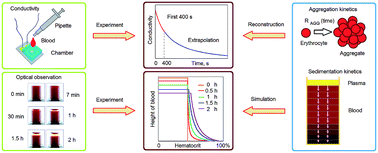当前位置:
X-MOL 学术
›
Anal. Methods
›
论文详情
Our official English website, www.x-mol.net, welcomes your
feedback! (Note: you will need to create a separate account there.)
Electrochemical impedance spectroscopy of blood. Part 3: a study of the correlation between blood conductivity and sedimentation to shorten the erythrocyte sedimentation rate test†
Analytical Methods ( IF 2.7 ) Pub Date : 2017-11-20 00:00:00 , DOI: 10.1039/c7ay01696d A. Zhbanov 1, 2, 3, 4 , S. Yang 1, 2, 3, 4, 5
Analytical Methods ( IF 2.7 ) Pub Date : 2017-11-20 00:00:00 , DOI: 10.1039/c7ay01696d A. Zhbanov 1, 2, 3, 4 , S. Yang 1, 2, 3, 4, 5
Affiliation

|
The study of erythrocyte aggregation and erythrocyte sedimentation rate (ESR) is very important both for basic research and medical applications. The duration of the Westergren ESR test is one hour which seems excessive. The hematocrit and conductivity of blood demonstrate high correlation. This makes it possible to evaluate the erythrocyte aggregation kinetics and ESR by measuring changes in the blood conductivity. We measured the time-dependent changes in conductivity at the bottom of the blood column during sedimentation. A digital camera is used to obtain the blood sedimentation curve and to determine the hematocrit profile. The effective conductivity of blood is calculated based on effective medium theory. Simple analytical expressions are derived to extrapolate changes in blood conductivity over time. We proposed an improved physical model of sedimentation which reveals additional information about the kinetics of blood sedimentation and erythrocyte aggregation. An explicit expression is obtained to characterize the rate of aggregate formation. A numerical model was developed to investigate these mechanisms, and it was tested by comparing simulation results with experimental data. Based on our model, the ESR, blood sedimentation curve and hematocrit profiles can be numerically restored using only the first 400 seconds of the recorded changes in blood conductivity. The proposed technique allows measuring the erythrocyte aggregation as well as the sedimentation kinetics. The changes in blood conductivity at the bottom of the blood column at the initial stage of sedimentation reliably reflect the erythrocyte aggregation kinetics and ESR over time.
中文翻译:

血液的电化学阻抗谱。第3部分:研究血液电导率与沉降之间的相关性以缩短红细胞沉降速率测试†
红血球聚集和红血球沉降速率(ESR)的研究对于基础研究和医学应用都非常重要。Westergren ESR测试的持续时间为一小时,这似乎太长了。血细胞比容和血液电导率显示出高度相关性。这使得可以通过测量血液电导率的变化来评估红细胞聚集动力学和ESR。我们在沉积过程中测量了血柱底部电导率随时间的变化。使用数码相机获取血液沉降曲线并确定血细胞比容曲线。血液的有效电导率是根据有效介质理论计算得出的。可以得出简单的分析表达式来推断血液电导率随时间的变化。我们提出了一种改进的沉降物理模型,该模型揭示了有关血液沉降和红细胞聚集动力学的其他信息。获得一个明确的表达式来表征聚集体形成的速率。建立了一个数值模型来研究这些机制,并通过将模拟结果与实验数据进行比较来对其进行测试。根据我们的模型,仅使用所记录的血液电导率变化的前400秒,就可以在数值上恢复ESR,血液沉降曲线和血细胞比容曲线。所提出的技术允许测量红细胞聚集以及沉降动力学。在沉积初期,血柱底部血液电导率的变化可靠地反映了随着时间的流逝,红细胞聚集动力学和ESR。
更新日期:2017-11-20
中文翻译:

血液的电化学阻抗谱。第3部分:研究血液电导率与沉降之间的相关性以缩短红细胞沉降速率测试†
红血球聚集和红血球沉降速率(ESR)的研究对于基础研究和医学应用都非常重要。Westergren ESR测试的持续时间为一小时,这似乎太长了。血细胞比容和血液电导率显示出高度相关性。这使得可以通过测量血液电导率的变化来评估红细胞聚集动力学和ESR。我们在沉积过程中测量了血柱底部电导率随时间的变化。使用数码相机获取血液沉降曲线并确定血细胞比容曲线。血液的有效电导率是根据有效介质理论计算得出的。可以得出简单的分析表达式来推断血液电导率随时间的变化。我们提出了一种改进的沉降物理模型,该模型揭示了有关血液沉降和红细胞聚集动力学的其他信息。获得一个明确的表达式来表征聚集体形成的速率。建立了一个数值模型来研究这些机制,并通过将模拟结果与实验数据进行比较来对其进行测试。根据我们的模型,仅使用所记录的血液电导率变化的前400秒,就可以在数值上恢复ESR,血液沉降曲线和血细胞比容曲线。所提出的技术允许测量红细胞聚集以及沉降动力学。在沉积初期,血柱底部血液电导率的变化可靠地反映了随着时间的流逝,红细胞聚集动力学和ESR。









































 京公网安备 11010802027423号
京公网安备 11010802027423号